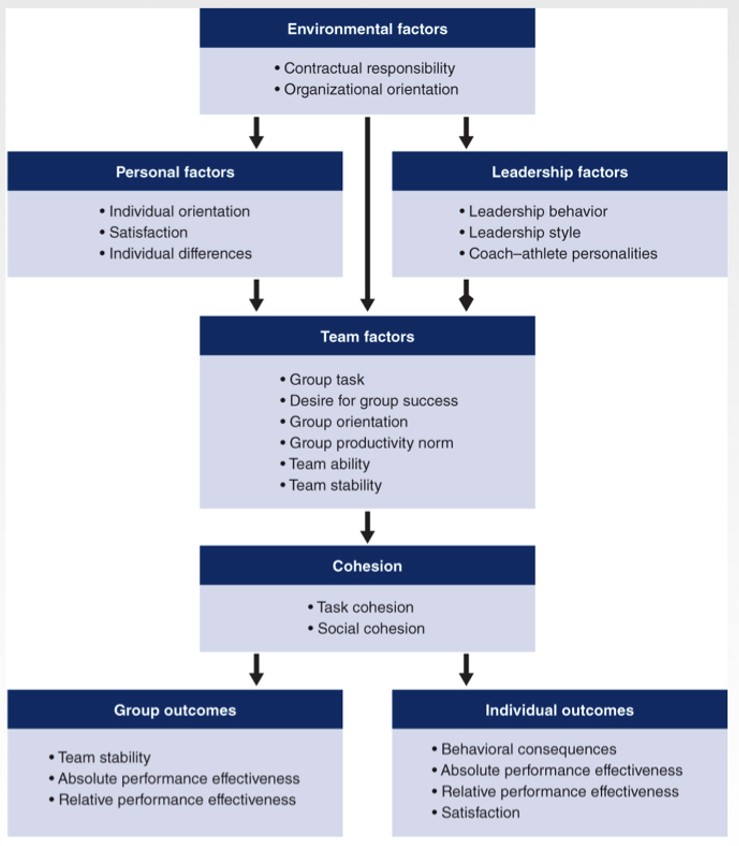Group and Team Dynamics Pt 2
1/16
There's no tags or description
Looks like no tags are added yet.
Name | Mastery | Learn | Test | Matching | Spaced |
|---|
No study sessions yet.
17 Terms
What is cohesion?
total field of forces which act on members of the group
What are the 2 parts of cohesion for the individual?
attractiveness of group: individual’s desire for interpersonal interactions with other group members and desire to be involved in group activities
do I want to be involved?
means of control: benefits member can derive from being associated with that group
what am I getting out of it
What are the characteristics of cohesion?
multidemensional, dynamic, instrumental/purposeful, affective (social interactions)
What is task cohesion?
degree to which members of a group work together to achieve common goals; teammwork
What is social cohesion?
degree to which members of group like each other and enjoy one another’s company
What are the parts of the conceptual model of cohesion?
environmental factors: normative forces holding a group together; contracts, scholarships, geographical restrictions, regulations, etc
not related to people - scholarship, resources, weather, etc
personal factors: individual characteristics of group members: demographics, behaviors, thoughts and motives, individual satisfaction
leadership factors: leadership style and behaviors and relationship established with group
what leader does (coach)
team factors: group takes characteristics, group productivity norms, desire for group success, group roles, group position and team stability
outcomes: bother group and individual

What is the conceptual model of cohesion?
used to systematically study cohesion in sport and exercise
personal factors, leadership factors, team factors, outcomes
What is the relationship between cohesion and performance?
positive relationships between higher cohesion and better performance
What can the relationship between cohesion and performance be influenced by?
task demands and the direction of causality
What are task demands?
task demands: continuum from interaction to coactive
interaction - team members work together to coordinate their actions
coactive - much less, if any, interaction and coordination for achievement of goals
generally, find cohesion can influence both types, though higher levels of cohesiveness in interactive tasks/teams
What is the direction of causality?
direction of causality: does cohesion influence performance or does performance influence cohesion
difficult to establish; likely positive feedback cycle
What are other factors associated with cohesion?
team satisfaction: closely related to cohesion, likely circular relationship of sorts
conformity: may see more conformity to various team norms w/ higher cohesive groups; might be productivity norms or social norms
adherence: better adherence with higher levels of cohesion (more attendance, less attrition, positive affect and efficacy)
stability: both turnover rate and lengths of time group members been together
social support
group goals
collective efficacy: group believe can achieve goal
How can cohesion be built in exercise settings?
group name, group t-shirts or headbands etc
How can cohesion be built in sports settings?
group norms, individual roles, distinctiveness, individual sacrifice, communication and interaction
shared team values: identify team goals and a team mission, start with values
clarify path to achieving goals, build trust among players and coaches
examples: morality, teamwork, honesty, cooperation, communication, winning, fairness, accountability
What are the guidelines for coaches and leaders in building team cohesion?
effective communication
DESC - describe situation, express feelings, specifying the changes you want to make, consequences
explain individual roles in team success
develop pride within subunits
set challenging group goals
encourage group identity
avoid formation of social cliques
employ transformation leadership
avoid excessive turnover
conduct periodic team meetings
enhance team efficacy
get to know others - enhance personal disclosure
How can group members increase cohesion?
get to know other members
help whenever possible
give positive reinforcement
be responsible
communicate honestly and openly w/ coach and leader
resolve conflicts immediately
give full effort at all times
What are some barriers to group cohesion?
clash of personalities in group
conflict of task/social roles
breakdown in communication amount members or between leader and members
1+ members struggling for power
frequent turnover of group members
disagreement on group goals and objectives